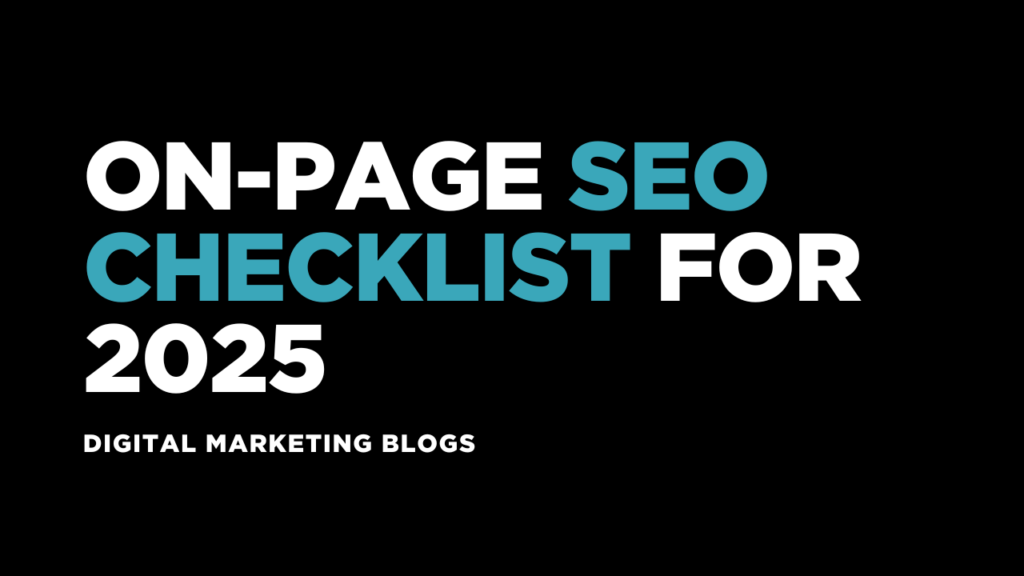Search engine optimization is evolving rapidly. In 2025, on-page SEO is more important than ever for businesses and content creators aiming to rank higher and deliver better user experiences. This guide provides an up-to-date checklist to ensure your pages are optimized to meet the latest SEO standards and search engine algorithms.
Why On-Page SEO Still Matters
While off-page SEO like backlinks and social signals plays a role, on-page SEO directly influences how well your content communicates with search engines and users. From content quality to technical settings, on-page SEO helps:
- Improve search engine rankings
- Enhance user experience (UX)
- Increase organic traffic
- Boost click-through rates (CTR)
1. Conduct In-Depth Keyword Research
Keyword research remains foundational. For 2025, focus on:
- Search intent: Understand what users really want
- Long-tail keywords: More specific queries often lead to higher conversions
- Semantic keywords: Use related terms to improve topical relevance
Tools to use: Google Keyword Planner, Ahrefs, Semrush, Ubersuggest.
2. Craft Compelling Meta Titles and Descriptions
Meta tags remain critical for click-through rates and indexing. Best practices include:
- Keep titles under 55 characters
- Include power and emotion words
- Use your main keyword naturally
- Write meta descriptions under 155 characters
3. Structure Content with Proper Headings
Use H1 for the title, and H2/H3 tags to organize sections clearly. This improves readability and helps search engines understand content hierarchy.
Example structure:
- H1: Page Title
- H2: Main Section
- H3: Subsection
4. Optimize URL Structures
Your URLs should be clean, descriptive, and keyword-rich. Avoid dynamic strings or unnecessary parameters.
Best practices:
- Use hyphens instead of underscores
- Keep it short and readable
- Include the primary keyword
Example: /on-page-seo-checklist-2025
5. Use Internal and External Links Strategically
Link to other relevant internal pages and authoritative external sources.
- Internal links keep users on your site longer
- External links enhance trust and credibility
Here’s a great resource on digital marketing in Kerala that explores regional SEO strategies.
6. Optimize Images with ALT Tags and Compression
Images contribute to SEO through ALT attributes and performance.
- Include descriptive, keyword-relevant ALT text
- Compress images to reduce load time
- Use modern formats like WebP
7. Focus on E-E-A-T and User Experience
Google emphasizes E-E-A-T: Experience, Expertise, Authoritativeness, and Trustworthiness.
- Display author bios and credentials
- Use clear navigation and mobile-responsive design
- Include contact information and policies
8. Improve Page Speed and Core Web Vitals
Fast-loading pages improve UX and SEO. Use Google PageSpeed Insights and Lighthouse to monitor:
- LCP (Largest Contentful Paint)
- FID (First Input Delay)
- CLS (Cumulative Layout Shift)
Fix issues related to JavaScript, image sizes, and server speed.
9. Implement Schema Markup
Structured data helps search engines better understand your content.
- Use JSON-LD format
- Add relevant schema: Article, Product, FAQ, Local Business
- Test with Google’s Rich Results Tool
10. Optimize for Voice and Visual Search
In 2025, more searches happen via voice assistants and image recognition.
Voice search tips:
- Use natural language and question-based phrases
- Include concise answers in paragraph or list format
Visual search tips:
- Use high-quality images
- Add descriptive filenames and ALT text
11. Ensure Mobile-First Design
Google prioritizes mobile versions of websites. Your site must:
- Be responsive on all devices
- Use readable font sizes
- Avoid intrusive interstitials
12. Update Content Regularly
Search engines favor fresh, accurate content.
- Refresh outdated information
- Add new insights or data
- Re-optimize for updated keywords
13. Secure Your Site with HTTPS
Security is a ranking factor. Ensure all pages use HTTPS and renew SSL certificates regularly.
Final Thoughts
Following this on-page SEO checklist for 2025 will keep your website competitive, user-friendly, and aligned with the latest search engine standards. As SEO becomes more nuanced and user-focused, staying updated and consistent with best practices is key to long-term success.
Use this checklist as part of your ongoing SEO strategy to stay ahead in the digital landscape.



